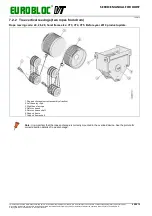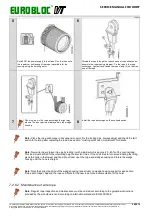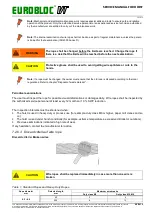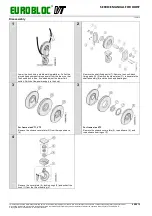
EUROBLOC
SERVICE MANUAL FOR HOIST
147/212
This document and the information contained herein, is the exclusive property of Verlinde S.A.S. and represents a non-public, confidential and proprietary trade secret that
may not be reproduced, disclosed to third parties, altered or otherwise employed in any manner whatsoever without the express written consent of Verlinde S.A.S.
Copyright © (2013) Verlinde S.A.S. All rights reserved.
06/2015
7.2.5.1 Maintenance of sheave support and rope anchorage support
Low headroom trolley and Normal headroom trolley. Reeving: 02 and 04.
1
2
Check that the support shaft and the rope anchorage plate
(or overload device) are correctly in their slots. Check that
fixing screws are tight. Lubricate the load carrying surfaces
in the ends of the shaft and the rope anchorage plate with a
small amount of grease.
Check that the locking part is in the groove of the shaft in
cases which there is no other block against the shaft axial
movement.
Check that the sheave block and the rope anchorage can
freely tilt with rope.
7.2.6 Wire rope
The rope of the hoist is a wearing, load-bearing part. In order to ensure safe and efficient operation of the hoist, it is
essential to follow the safe working principles that are described in the safety instructions. Regular inspection of the
rope is a vital safety procedure requirement.
Structure of wire ropes
1. Rope
2. Strand
3. Wire
4. Outer strand layer
5 Inner strand layer
6. Rope core
Standard and heavy-duty wire ropes have eight outer strands and steel core. The steel core is covered by plastic in
heavy-duty rope. The lay of the outer strands is left-handed in single rope hoists. True vertical hoists have two
ropes, one with left hand lay and another with right hand lay. Rotation resistant ropes have more outer strands than
standard ropes. Outer strands have left hand lay, while inner strands have right hand lay.
The lay of strands (wire rope) can be twisted either to the left or to the right. To determine whether the lay is left- or
right-handed, examine the rope by looking up to the length of a rope whether the wires turn anti-clockwise (left-
handed) or clockwise (right-handed).





































